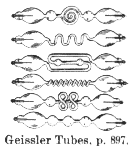Geissler tube

.jpg)
A Geissler tube[1] is an early gas discharge tube used to demonstrate the principles of electrical glow discharge. The tube was invented by the German physicist and glassblower Heinrich Geissler in 1857. It consists of a sealed, partially evacuated glass cylinder of various shapes with a metal electrode at each end, containing rarefied gasses such as neon, argon, or air; mercury vapor or other conductive fluids; or ionizable minerals or metals, such as sodium. When a high voltage is applied between the electrodes, an electrical current flows through the tube. The current dissociates electrons from the gas molecules, creating ions, and when the electrons recombine with the ions, the gas emits light by fluorescence. The color of light emitted is characteristic of the material within the tube, and many different colors and lighting effects can be achieved. The first gas-discharge lamps, Geissler tubes were novelty items, made in many artistic shapes and colors to demonstrate the new science of electricity. In the early 20th century, the technology was commercialized and evolved into neon lighting.


Application
Geissler tubes were mass-produced from the 1880s as entertainment devices, with various spherical chambers and decorative serpentine paths formed into the glass tube. When the tube was handled (the terminals were insulated) the shape of the plasma changed. Some tubes were very elaborate and complex in shape and would contain chambers within an outer casing. If these were spun at high speed a visual disk of color was seen due to persistence of vision. (Somewhat similar devices in the form of stationary globes are now produced and sold for personal amusement.) As an educational tool they are also used to demonstrate the movement of electrons and the principles of a vacuum.
Influence
It was observed that under some conditions the glass envelope would itself glow at the positive (anode) end. This glow was attributed to the transmission of a ray from the negative cathode at the opposite end of the device, and so were named cathode rays. William Crookes developed a modification of the Geissler tube into what is known as the Crookes tube to demonstrate and study these rays, later determined to be a stream of electrons. This device was further developed into the cathode ray tube with applications in electronics development and diagnosis, and in radar and television displays.
Geissler tubes have had a large impact on the development of many instruments and devices all of which use related vacuum and discharge principles.
- Xenon flash lamps (for flash photography),
- Xenon arc lamps (for automobile headlights),
- X-ray tubes,
- sodium vapor lamps of low and high pressure,
- "Neon" signs (both using visible light discharge from neon and other gases and indirectly through phosphor excitation from ultraviolet light)
- Mercury vapor lamps,
- Mass spectrometry devices,
- Cathode ray tube (employed in the oscilloscope and later as a television, radar, and computer display device),
- Electrotachyscope (an early moving picture display device), and
- Fluorescent lamps.
See also
- William Crookes
- Cathode ray tube
- Crookes tube
- Induction coil
- Neon sign
- Plasma globe
- X-ray tube
- German inventors and discoverers
| Wikimedia Commons has media related to Geissler tubes. |
References
External links
- Sparkmuseum: Crookes and Geissler Tubes
- Instruments for Natural Philosophy: Geissler Tubes
- Mike's Electric Stuff: Geissler Tubes
- The Cathode Ray Tube site
- Geissler and Crookes tubes shown working
- How to Make an Experimental Geissler Tube, Popular Science monthly, February 1919, Unnumbered page, Scanned by Google Books.